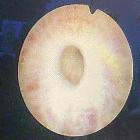kongenitale Urethrastenose

Cobb's collar (also known as a Moormann's ring or congenital narrowing of the bulbar uerthra) is a membranous stricture of the bulbar urethra just downstream of the external urethral sphincter. It is sometimes referred to as a type III posterior urethral valve, and does not maintain a connection to the verumontanum.
Terminology
The terminology of posterior urethral valves (PUV) is largely based on the three level classification proposed by Young et al in 1919 . The distinction between type I/II and type III has mostly revolved around proposed differences in valve morphology and embryological origin. A type III is thought to be a persistent membranous remnant of the urogenital membrane.
The urology literature is inconsistent. Cobb's collar may be considered synonymous with type III PUV; there, there is sometimes a distinction made between PUV versus Cobb's collar on the basis persistent attachment to verumontanum.
Epidemiology
It is an uncommon finding on a pediatric voiding/micturating cystourethrogram (VCUG). It must be differentiated from normal variant, as an indentation of the bulbar urethra is seen in more than half of boys who undergo cystoscopy.
Pathology
One is a congenital urethral obstruction which is thought to be due to incomplete widening of the urogenital diaphragm and is a membrane with a central hole without any connection to the verumontanum. Video-endoscopic recording correlated with radiological imaging now better define anatomy and pathology that has also been given the names of Young's type III valves, congenital stricture and prolapsed Type III valves.
Apart from the fibrous type of obstruction, the other type of anomaly is due to contraction of the lower end of what is now known to be a tubular external sphincter, the bottom end of which can on occasion obstruct the passage of a catheter and the contrast . The resultant appearance is that of a funneling change, rather than a sharp demarcation. There can be a variable morphological degree of narrowing due to variation of the prominence of the lower end of the sphincter and fluctuation in the degree of contraction.
Cobb's collar is associated with syringoceles ; the latter being a cystic dilatation of the Cowper's gland duct.
Siehe auch:

 Assoziationen und Differentialdiagnosen zu kongenitale Urethrastenose:
Assoziationen und Differentialdiagnosen zu kongenitale Urethrastenose:
